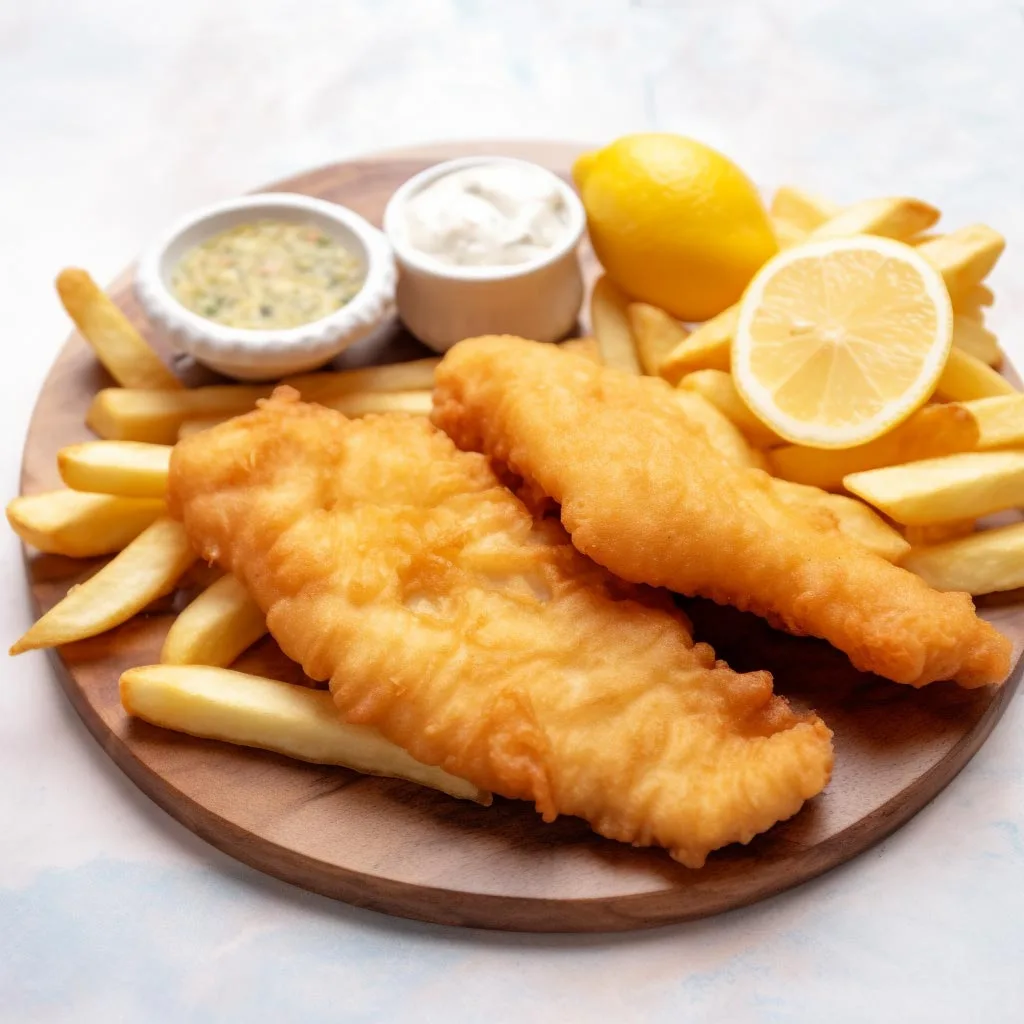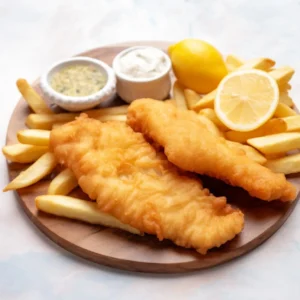
Fish and chips, a staple of British cuisine, has delighted palates for generations. This dish, which consists of fried fish served alongside chunky fried potatoes, is a perfect example of simplicity meeting flavour. It’s fascinating to consider how such a straightforward dish became a culinary icon in Britain and beyond.
The origins of fish and chips are as interesting as the dish itself. While fried fish was introduced in Britain by Western Sephardic Jews in the 17th century, the concept of serving it with chips came about in the 19th century.
It’s thought to have originated in the North of England, with claims of the first fish and chip shop opening in either London or Lancashire. This meal was a hearty response to the needs of the working class, providing affordable and nourishing food.
Regarding difficulty, fish and chips is a remarkably approachable recipe for cooks of all skill levels. The ingredients are simple, and the cooking process is straightforward. It’s an excellent dish for beginners to try their hand at deep frying and battering, two techniques that are fundamental in many cuisines.
What makes fish and chips particularly appealing is its versatility. While traditionally made with cod or haddock, you can easily substitute these for other types of white fish like pollock or tilapia.
The batter, too, can be varied – some prefer a beer batter for extra lightness and flavour, while others stick to the basic flour and water combination. The chips, chunky and hand-cut, are a comforting constant, but even here, there’s room for experimentation with different types of potatoes or seasonings.
This dish also carries a sense of nostalgia and community. In many British towns, fish and chip shops – or ‘chippies’ as they’re affectionately known – are local meeting spots, bringing together people from all walks of life.
The smell of freshly fried fish and chips wrapped in paper is a memory many hold dear, a reminder of simple pleasures and communal joy.
Fish and chips also play a significant role in British culture and history. During both World Wars, the government made sure that fish and chips were one of the few foods not subject to rationing.
This decision was a testament to the dish’s importance in boosting morale and providing sustenance during tough times.
Moreover, fish and chips is a dish that has travelled well beyond the shores of Britain. It’s enjoyed worldwide, with each country adding its unique twist to it.
From the addition of spices in the batter to serving with different sides like mushy peas or tartare sauce, the global variations of fish and chips are a testament to its universal appeal.
Fish and chips is more than just a meal; it’s a symbol of comfort, a culinary tradition, and a dish that brings people together. Its simplicity, versatility, and deep-rooted history make it a recipe worth exploring and enjoying in your kitchen.
Expert Tip: For extra crispy chips, soak the cut potatoes in water for at least 30 minutes before frying to remove excess starch. Dry them thoroughly to ensure they crisp up beautifully when fried.
It’s essential to understand that each component in fish and chips plays a crucial role in creating the perfect balance of textures and flavours. Now, let’s explore each ingredient and its significance.
Potatoes: Potatoes are vital for making the perfect chips. They should be starchy to ensure they crisp up nicely on the outside while remaining fluffy inside. Maris Piper or King Edward potatoes are excellent choices.
If you can’t find these, any high-starch potato will do. The key to good chips is in the potato’s ability to hold its shape and provide a satisfying crunch.
Cod or Haddock: These fish are traditional choices due to their mild flavour and flaky texture. They hold up well to frying and absorb the batter beautifully, creating a delightful contrast with the crispy exterior. If you’re looking for alternatives, try pollock or tilapia, which also have a mild flavour and firm texture.
Plain Flour: The base of the batter, plain flour is preferred for its ability to create a light, crispy coating. It’s essential for achieving the golden crust that makes this dish so appealing. If you need a gluten-free option, rice flour or chickpea flour can be great substitutes.
Baking Powder: This ingredient is a small but mighty addition to the batter. It reacts with the liquid to create tiny bubbles, giving the batter its lightness and crispiness. Without it, the batter might be too dense.
Ice-cold Water: The temperature of the water is crucial. Ice-cold water prevents gluten development in the flour, ensuring the batter is light and crispy rather than chewy. It’s a simple trick that makes a significant difference in the texture.
Salt and Black Pepper: These seasonings are key to enhancing the natural flavours of the fish and chips. Salt brings out the taste, while black pepper adds a subtle warmth. They’re simple but essential for seasoning both the batter and the chips.
Vegetable Oil: A neutral oil with a high smoking point, like vegetable oil, is perfect for frying as it doesn’t impart any additional flavour to the food and can be heated to high temperatures without burning. It ensures the fish and chips cook evenly and become perfectly crispy.
Malt Vinegar: A classic British condiment, malt vinegar adds a tangy, sharp flavour that complements the richness of the fried fish and chips. It’s a traditional accompaniment that brings a zesty contrast to the dish.
Each ingredient in fish and chips is selected to contribute to the overall harmony of the dish. The crispiness of the batter, the flakiness of the fish, and the crunch of the chips all come together to create a satisfying and beloved meal.
Expert Tip: When frying the fish, don’t overcrowd the pan. This keeps the oil temperature stable, ensuring each piece cooks evenly and turns golden brown without absorbing too much oil.
Absolutely! While cod and haddock are traditional choices due to their mild flavour and flaky texture, you can experiment with other white fish like pollock, tilapia, or even flounder. The key is to choose fish that can hold up to frying without falling apart.
The secret to a crispy batter lies in a few factors: using ice-cold water, ensuring your oil is at the right temperature (180°C/350°F for the fish and 190°C/375°F for the chips), and not over-mixing the batter. Over-mixing can develop gluten, making the batter chewy. Also, make sure the fish is patted dry before dipping it in the batter.
For a healthier version, you can bake both the fish and chips in the oven. Coat the fish in breadcrumbs instead of batter and bake it until crispy. For the chips, toss them in a small amount of oil and bake until golden. Remember, though, that this method won’t replicate the exact taste and texture of traditional fried fish and chips.
You can cut the potatoes into chips and soak them in water in the fridge to remove excess starch. This step can be done a few hours in advance. However, the fish should be battered and fried just before serving to maintain its crispiness.
Classic accompaniments include tartare sauce, mushy peas, and a wedge of lemon. Malt vinegar is also a traditional topping that adds a tangy flavour. You can also serve it with coleslaw or a side salad for a fresh contrast to the fried elements.
Leftover fish and chips can be stored in an airtight container in the refrigerator for up to two days. To reheat, place them in a preheated oven at 180°C/350°F for about 10 minutes or until heated through and crispy again. Microwaving is not recommended as it can make the batter soggy.
Expert Tip: Experiment with the batter by adding a sparkling water. This creates a lighter, airier batter, giving the fried fish a wonderfully crisp texture that enhances the overall experience.
Here are some more recipes for you to enjoy! If you my recipes don’t forget to rate and leave a comment.
If you have any recipe suggestions, please do not hesitate to ask me. A great way to stay in contact with me is through Instagram, Facebook, Twitter and YouTube. Don’t forget to tag me @CookwithNabeela in your recipe photos!

Subscribe now to receive my latest recipes directly in your inbox. Stay up-to-date and never miss out!

I love to cook! I want to share with you my favourite, delicious family-friendly recipes. I want to inspire you to create fantastic food for your family every day.
Add your first comment to this post